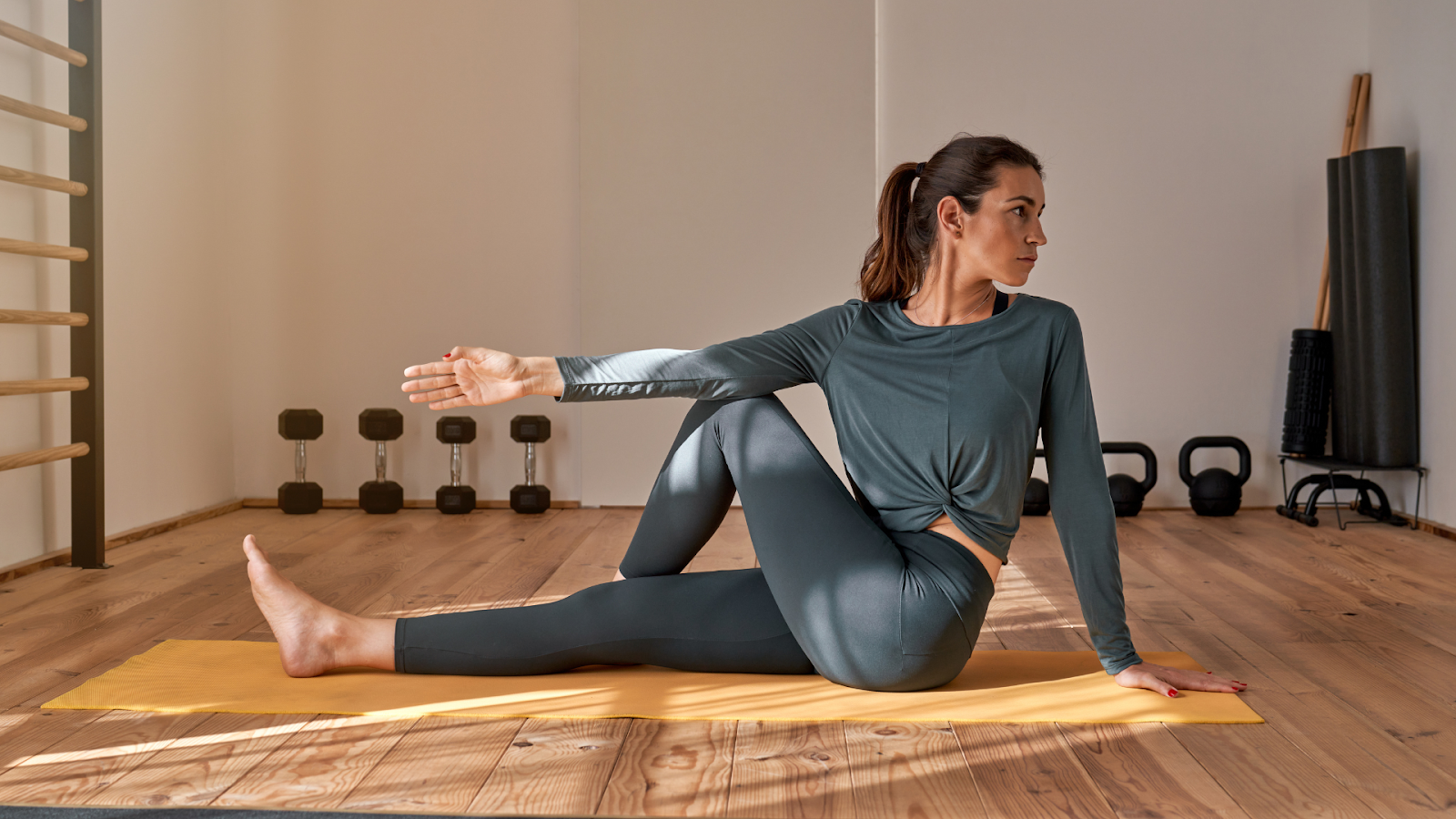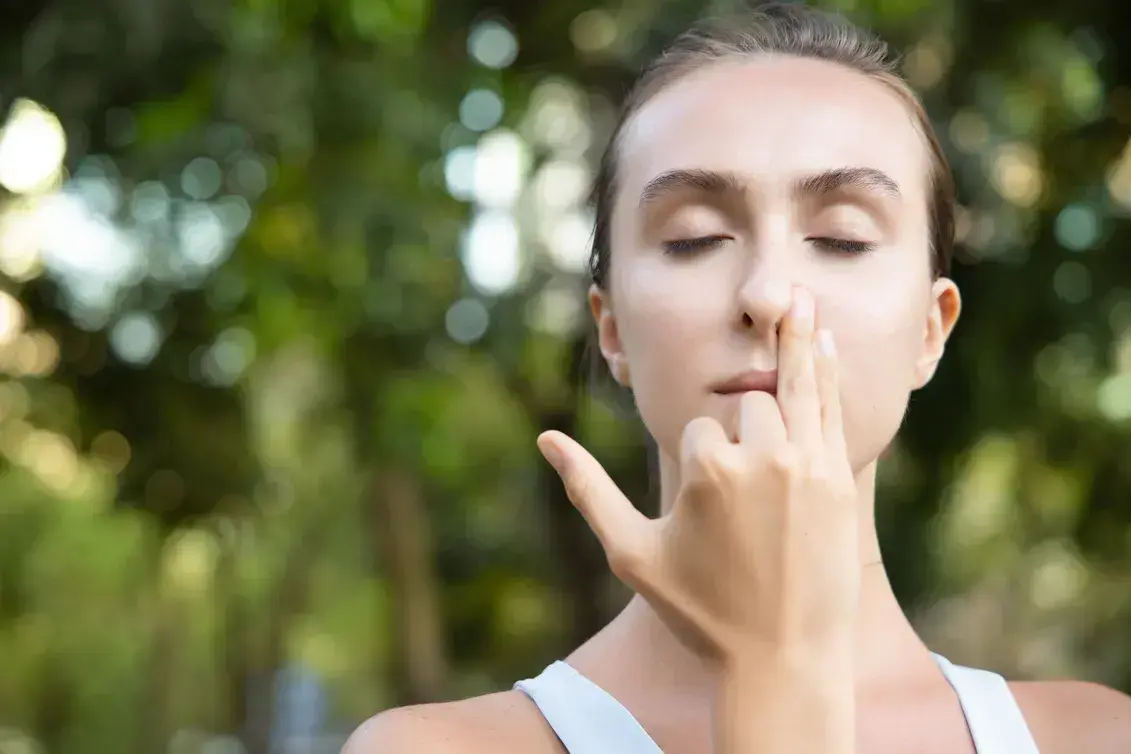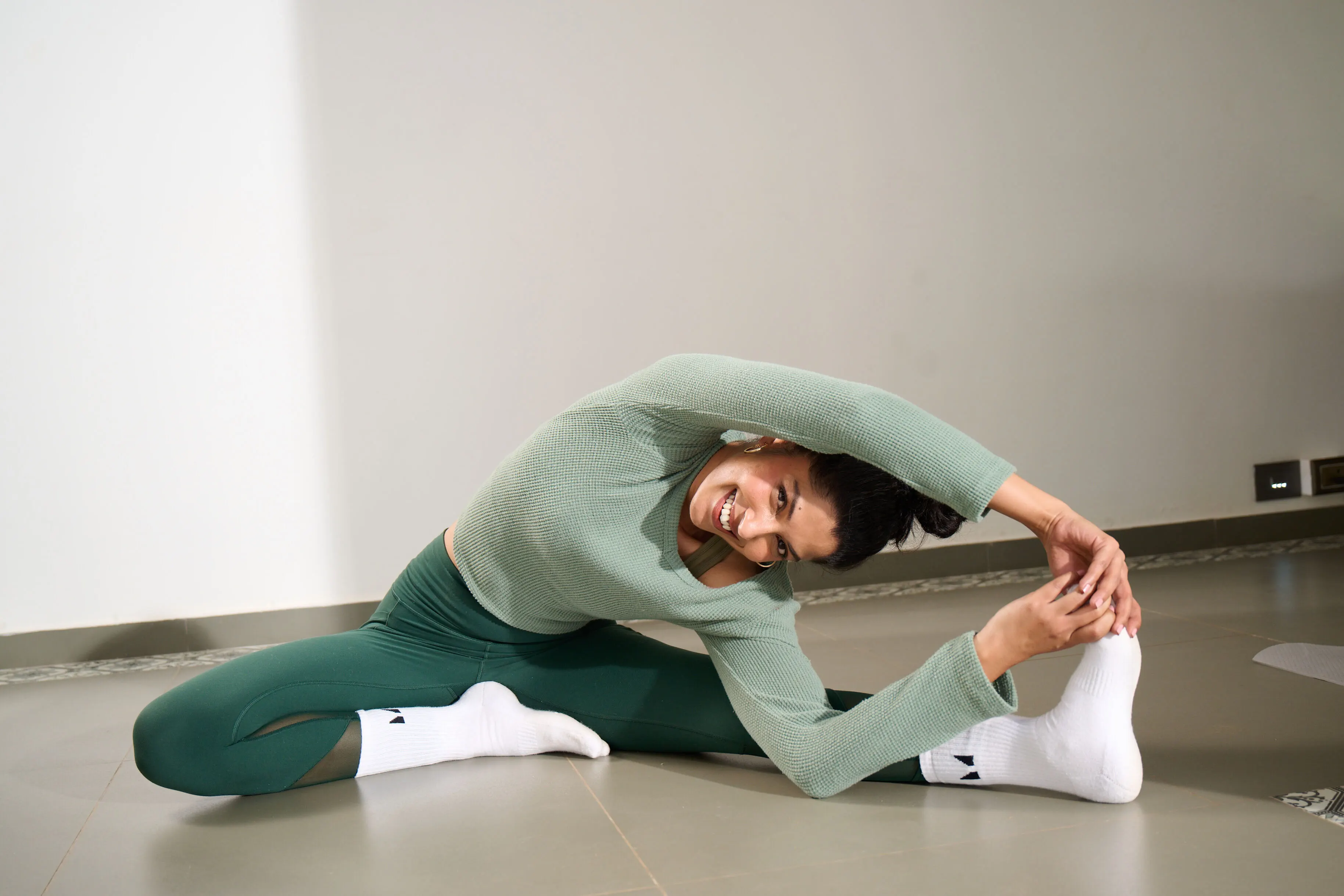What is Kati Chakrasana?
Kati Chakrasana, also known as the standing spinal twist pose, is a standing yoga posture that emphasizes twisting the spine and waist. This asana involves standing with feet shoulder-width apart, raising the arms to shoulder height, and twisting the torso side to side. It helps improve spinal flexibility, tones the abdominal muscles, and enhances digestion. The gentle twisting motion also aids in relieving tension in the lower back and improving overall posture. Kati Chakrasana is beneficial for enhancing body awareness and can be a part of both warm-up sequences and cool-down routines in yoga practice.
Position type: Standing
Posture type: Twist
Ideal for: Flexibility
Targets: Back and abdomen
Pose level: Beginner
How to prepare for Kati Chakrasana?
- Flexibility: Since it is a beginner-level twisting posture, Kati Chakrasana can be performed before more advanced poses. To prepare, start with basic warm-up exercises to loosen up the body. Gentle side bends from a standing position and seated twists in Sukhasana (Easy Pose) can help release tension in the spine and waist. Incorporate a few rounds of Surya Namaskar (Sun Salutation) to stretch and activate the muscles. Additionally, practicing spinal flexibility exercises like Cat-Cow Pose, Seated Forward Bend, and Standing Forward Bend will enable you to perform Kati Chakrasana with greater ease and depth.
- Core strength: Building core strength is essential for maintaining proper alignment and holding the pose for longer durations. Asanas like Triangle Pose, Warrior Poses, Chair Pose, Boat Pose, and various Plank Pose variations can significantly enhance core stability. A strong core supports the lower back and ensures a smooth and controlled twisting motion in Kati Chakrasana.
How to do Kati Chakrasana? Getting into the posture:
- Stand upright with your feet shoulder-width apart and arms by your sides. Relax your body and take a few deep breaths.
- Inhale deeply and extend both arms straight out to the sides at shoulder height, parallel to the ground, with palms facing downward.
Twist to the Right:
- As you exhale, twist your upper body to the right.
- Keep your feet firmly planted on the ground and your hips facing forward.
- Allow your left hand to come in front of you, and your right hand to move behind you, both at shoulder height.
- Look over your right shoulder, ensuring your head follows the twist of your torso.
- Hold the twisted position for a few seconds, feeling the stretch in your waist and spine. Maintain steady breathing.
- Inhale and slowly return your torso and arms to the starting position, facing forward.
Twist to the Left:
- As you exhale again, twist your upper body to the left.
- Allow your right hand to come in front of you, and your left hand to move behind you, both at shoulder height.
- Look over your left shoulder, ensuring your head follows the twist of your torso.
- Hold the twisted position for a few seconds, maintaining steady breathing.
- Inhale and slowly return to the starting position with your arms outstretched at shoulder height.
Getting out of the posture:
- Practice the twist alternately to the right and left several times, focusing on a smooth and controlled motion.
- Lower your arms and relax your body, taking a few deep breaths to end the practice.
Key Alignments in Kati ChakrasanaKeep the feet firmly planted and hips facing forward to ensure stability. Maintain straight arms at shoulder height for balanced arm extension during the twist. Align the head with the torso, allowing the gaze to follow the direction of the twist, ensuring a smooth and cohesive motion.
What are the benefits of Kati Chakrasana?
Kati Chakrasana offers benefits for physical and mental well-being. It enhances spinal flexibility and mobility, which is crucial for maintaining a healthy and supple spine. The twisting motion aids in toning the abdominal muscles and improving digestion by stimulating the digestive organs. It also helps alleviate lower back pain and tension, promoting better posture. Additionally, Kati Chakrasana improves blood circulation and can reduce stiffness in the shoulders and neck. The gentle twisting action encourages detoxification by massaging internal organs and enhancing the body's natural detox processes. Mentally, this asana can help reduce stress and anxiety, promoting a sense of relaxation and calm.
What are the contraindications of Kati Chakrasana?
Kati Chakrasana should be approached with caution or avoided by those with severe back or spinal injuries as the twisting motion can exacerbate their condition. People with herniated discs or chronic back pain should consult a healthcare professional before attempting this asana. Individuals with recent abdominal surgery or issues like ulcers should avoid twisting poses, as they can put pressure on the abdomen. Pregnant women should also avoid this pose due to the twisting involved. Additionally, those with high blood pressure or heart conditions should practice under the guidance of a qualified instructor to ensure safety. Always listen to your body and avoid pushing beyond your limits.
Counter poses of Kati Chakrasana
Practice the asana on both sides. After completing both sides, gently bend to either side to ensure balance in the body. You can practice seated forward bend for a counter movement to the back or child’s pose for a few minutes. You can also stand still in Tadasana.
Variations of Kati Chakrasana
- Chair Kati Chakrasana: Sit on a chair with your feet flat and hip-width apart, arms extended to the sides at shoulder height. Twist your upper body to the right, keeping your hips square and feet grounded. Hold the position for a few breaths, then return to the center and repeat the twist on the left side. This variation is great for those who prefer a seated option or those who have leg or knee pain and prefer to practice sitting postures.

- Dynamic Kati Chakrasana: Stand with your feet shoulder-width apart and arms extended to shoulder height. As you exhale, twist your torso to the right and then quickly to the left in a rhythmic motion. Continue alternating sides with your breath, creating a dynamic flow that enhances flexibility and coordination.

- Kati Chakrasana with Shoulder Stretch: Stand with your feet shoulder-width apart and interlace your fingers behind your back, straightening your arms and squeezing your shoulder blades together. Twist your torso to the right, feeling a stretch in your shoulders and chest. Hold for a few breaths, then return to the center and repeat on the left side, deepening the shoulder stretch.
Advice for Beginners For beginners practicing Kati Chakrasana, it's important to start with a gentle approach to avoid overstretching or straining. Focus on maintaining a stable stance with feet firmly grounded and hips facing forward throughout the twist. Move slowly and mindfully, ensuring that the twist comes from the torso rather than forcing the movement with the arms. If you experience any discomfort, reduce the range of motion and consider using a chair for support to gradually build flexibility and strength.Shvasa tips for Kati Chakrasana
- Keep your abdominal muscles engaged throughout the twist to provide support for your spine and maintain balance. This helps in executing a controlled and stable movement.
- Aim for a comfortable range of motion without forcing the twist. Focus on alignment and smooth movements rather than trying to achieve a deep twist right away to prevent strain and injury. It helps to practice under the guidance of a teacher.
- Coordinate your breath with the twist. Inhale to prepare and exhale as you twist. Deep, rhythmic breathing can help you stay relaxed and deepen the twist gradually.
Meta Description: Learn how to practice Kati Chakrasana. Benefits, precautions, modifications and practice tips for Standing Spinal Twist.
Summary: Kati Chakrasana, also known as the standing spinal twist pose, is a standing yoga posture that emphasizes twisting the spine and waist.
FAQs:
- What is Kati Chakrasana?
Kati Chakrasana is a standing yoga posture that emphasizes twisting the spine and waist. It helps improve spinal flexibility, tones the abdominal muscles, and enhances digestion. The gentle twisting motion also aids in relieving tension in the lower back and improving overall posture. Kati Chakrasana is beneficial for enhancing body awareness and can be a part of both warm-up sequences and cool-down routines in yoga practice.
- What are the benefits of Kati Chakrasana?
Kati Chakrasana offers benefits for physical and mental well-being. It enhances spinal flexibility and mobility, which is crucial for maintaining a healthy and supple spine. The twisting motion aids in toning the abdominal muscles and improving digestion by stimulating the digestive organs. It also helps alleviate lower back pain and tension, promoting better posture. Mentally, this asana can help reduce stress and anxiety, promoting a sense of relaxation and calm.
- What are the contraindications of Kati Chakrasana?
Kati Chakrasana should be approached with caution or avoided by those with severe back or spinal injuries as the twisting motion can exacerbate their condition. People with herniated discs or chronic back pain should consult a healthcare professional before attempting this asana. Individuals with recent abdominal surgery or issues like ulcers should avoid twisting poses, as they can put pressure on the abdomen. Pregnant women should also avoid this pose due to the twisting involved.
- How to do Kati Chakrasana?
- Stand upright with your feet shoulder-width apart and arms by your sides. Relax your body and take a few deep breaths.
- Inhale deeply and extend both arms straight out to the sides at shoulder height, parallel to the ground, with palms facing downward.
Twist to the Right:
- As you exhale, twist your upper body to the right.
- Keep your feet firmly planted on the ground and your hips facing forward.
- Allow your left hand to come in front of you, and your right hand to move behind you, both at shoulder height.
- Look over your right shoulder, ensuring your head follows the twist of your torso.
- Hold the twisted position for a few seconds, feeling the stretch in your waist and spine. Maintain steady breathing.
- Inhale and slowly return your torso and arms to the starting position, facing forward.
Twist to the Left:
- As you exhale again, twist your upper body to the left.
- Allow your right hand to come in front of you, and your left hand to move behind you, both at shoulder height.
- Look over your left shoulder, ensuring your head follows the twist of your torso.
- Hold the twisted position for a few seconds, maintaining steady breathing.
- Inhale and slowly return to the starting position with your arms outstretched at shoulder height.
- Practice the twist alternately to the right and left several times, focusing on a smooth and controlled motion.
- Lower your arms and relax your body, taking a few deep breaths to end the practice.














.jpg)












%201.png)

%201.svg)






%201.svg)